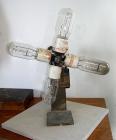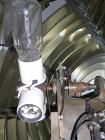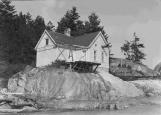20
Joyce Godard remembers:It was my job to clean the prisms and the brass. I hate brass. The lenses are like triangular prisms of heavy glass and at that time it was a Coleman lamp in the centre. So you had to get in and clean all the prisms inside and outside and then the mercury bath was in a big tank about three feet high, I guess. And it was all brass. And it all had to be cleaned…hours. Well, it had to be done every week. It had to be kept up. the lenses were like triangular prisms of heavy glass and at that time it was a Coleman lamp in the centre. So you had to get in and clean all the prisms inside and outside and then the mercury bath was in a big tank about three feet high I guess and it was all brass.
22
Electric lamp used in the 3rd order Fresnel lens at Point Atkinson.2004
Point Atkinson, West Vancouver, British Columbia, Canada

23
By the 1960s, the clockworks were replaced with an electric motor.Jean Odlum remembers:
It was still kerosene, gas mantle lamps [for the light, but an electric motor had been installed] … then you don't have that 15 minutes, half an hour of winding that silly weight. Oh, it's altogether different now. It's so much easier.
In 1997, the light was removed and a smaller, less powerful light was installed. At the same time, operation of the light became automatic, eliminating the light keeper.
24
Interior of prism with electric light apparatus.2004
Point Atkinson, West Vancouver, British Columbia, Canada

25
Fog Horn"T.A. Fullerton, superintendent of Canadian Pacific Steamships, contacted the port warden of Vancouver in August 1889, insisting that he inform the minister of Marine straightaway that 'the shipping interests of the port' required protection from fog while entering and leaving the harbour. 'Should any accident occur to any of the Steamers in the Narrows,' he warned, 'it would be a serious matter to a young town like Vancouver.' At the very least the department should install a fog alarm at Point Atkinson and build another manned lighthouse on Brockton Point, at the entrance to the inner harbour.
"The CPR seldom had to wait long for Ottawa to do its bidding. Within a matter of months a new fog alarm went up on the shoreline, three hundred yards west of the tower. The earliest horn, the 'Scotch siren,' was driven by steam pressure of at least fifty pounds, which spun a rotating drum - much like a giant kazoo. In 1902, J.P. Northey, a Toronto manufacturer, replaced the drum with a high velocity pulsating piston, a much more efficient design which he christened the diaphone. Northey's invention placed Canada at the forefront in lighthouse technology; a role abdicated only in the 1970s."
Don Graham, Keepers of the Light, 1985, pp. 66-67.
26
Fog could render the most powerful lens useless, so mariners also depended on an audible warning to alert them to danger. With the completion of the Canadian Pacific Railway in 1886, the port of Vancouver saw increased steamer traffic and Point Atkinson was fitted with a fog alarm in 1889 to assist with marine navigation in an increasingly congested port. Pollution from slash burning in Vancouver and burning sawdust in beehive burners contributed to low visibility on local waterways. Before the arrival of the fist foghorn system, keepers used a hand held fog alarm. Later, the handheld horn was used as backup.27
The first fog alarm was called a Scotch Siren and was powered by a coal-generated steam plant. The coal was landed annually by boat and hauled by derrick to the engine room. If the coal supply was exhausted, wood was gathered from the beach and cut from the surrounding area.28
The arrival of the fog alarm meant a dramatic increase in the volume of the keeper's duties. The light keeper continually watched for fog and put the horn into operation if visibility fell below three miles. It took approximately forty minutes from the time the fire was first lit to generate enough steam to run the horn. When the plant was running, the keeper had to constantly feed the engines with coal to maintain an adequate level of steam. The first fog horn building was located on the west side of the tower. A reservoir was built behind it to provide a constant supply of water to the boilers.29
Light keepers meticulously recorded the amount of fuel used by the fog alarm.1937
Point Atkinson, West Vancouver, British Columbia, Canada

30
Fog horn building.1930
Point Atkinson, West Vancouver, British Columbia, Canada
 Credits:
Credits:Courtesy of the Vancouver Maritime Museum.
31
When the present tower was built in 1912, the fog horn building was relocated right in front of the tower and the Scotch Siren was replaced by a powerful diaphone horn. The new horn acquired the nickname, "Old Wahoo." The six horsepower Fairbanks Morris engine that ran the new horn was housed in a separate building behind the tower. The deep sound of the diaphone comes from a cylindrical piston that lies inside an air chamber and moves with the force of compressed air. The first big sound was produced when the piston moved forward and the lower note was the result of the piston slowing down. The horn gave one blast of 2 ˝ seconds, every 57 ˝ seconds.32
The foghorn changed the keeper's responsibilities drastically: it shifted responsibility for sounding the alarm from the ship's captain to the keeper. According to Don Graham: "The arrival of a fog horn on a station entailed a revolutionary transformation of the keeper's responsibilities. Before the sounding of the horn was the prerogative of ship's captains. Steaming toward the harbour through fog, the captain gave the order to sound three rapid blasts of his ship's horn. When they heard this signal, Erwin and his fellow keepers would carry a hand-horn outside. This horn was a system of twin bellows, worked by wrenching a handle back and forth. Lightkeepers would pump away at prescribed intervals until signalled by the vessel to stop."Once the steam plant was built, however, ship's masters no longer initiated the signal. It was up to the keeper to shovel coal and raise steam whenever fog or smoke advanced to within four miles during squalls, heavy rain, or snowstorms. 'At all times, night and day…a careful watch on the weather is to be maintained,' Erwin was instructed, 'and on no account whatever is this regulation to be broken, even during prevailing clear weather.' The horn, sitting in its lair down below, was a mechanical tyrant." (Keepers, 67)
33
Engine and compressor for fog alarm.1930
Point Atkinson, West Vancouver, British Columbia, Canada
 Credits:
Credits:Courtesy of Dave Grafton.
